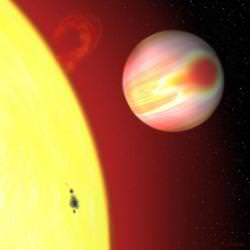While finding a planet orbiting another star is incredibly exciting, it’s almost becoming commonplace. The current exoplanet count is up to 270. So now that astronomers know where these exoplanets are located, they are currently devising new techniques in order to study the planets in detail. Using a new method similar to how polarized sunglasses filter away reflected sunlight to reduce glare, an international team of scientists were able to infer the size of an exoplanet’s atmosphere, plus directly trace the planet’s orbit.
Orbiting a dwarf star in the constellation Vulpecula and lying approximately 63 light years from earth, this exoplanet was discovered two years ago. Using this new polarization technique, the astronomers were able to see details about the planet called HD189733b that aren’t possible to observe using other indirect methods. The scientists extracted polarized light to enhance the faint reflected starlight “glare” from the planet, and for the first time, were able to detect the orientation of the planet’s orbit and trace its motion in the sky.
This new technique also indicates that the atmosphere of the planet is quite large, about 30% larger than the opaque body of the planet seen during transits, and probably consists of small particles, perhaps even tiny dust grains or water vapor.
Earlier studies of HD189733b using the Hubble Space Telescope indicated that this world doesn’t have any Earth-sized moons or a discernible ring system. Also, the temperature of its atmosphere is a blazing seven hundred degrees Celsius.
The planet is so close to its parent star that its atmosphere expands from the heat. Until now, astronomers have never seen light reflected from an exoplanet, although they have deduced from other observations that HD189733b probably resembles a “hot Jupiter,” a planet orbiting extremely closely to its parent star. Unlike Jupiter, however, HD189733b orbits its star in a couple of days rather than the 12 years it takes Jupiter to make one orbit of the sun.
“The polarimetric detection of the reflected light from exoplanets opens new and vast opportunities for exploring physical conditions in their atmospheres,” said Professor Svetlana Berdyugina, leader of the group from Zurich’s Institute of Astronomy and Finland’s Tuorla Observatory. “In addition, more can be learned about radii and true masses, and thus the densities of non-transiting planets.”
They discovered that polarization peaks near the moments when half of the planet is illuminated by the star as seen from the earth. Such events occur twice during the orbit, similar to half-moon phases.
Original News Source: Swiss Federal Institute of Technology Press Release


What a beautiful piece of work!
Great news. I would not have guessed that plorization filtration would have worked so nicely.
A NIT….
I see exoplanet suns are also erroneously yellow. Perhaps since this one is suppose to be a dwarf star that it is deemed yellow, too. Ug.
Nova Outburst. Wow, so active!
It often seems simple AFTER someone else thinks of it. We saw many photos of how polarization sun glasses cut glare, but never thought of using it as the opposite. Good work guys!
I think you meant to say polarized sunglasses, not Polaroid. Unless the sunglasses also take instant photos or need to be shaken for a minute after each use.
Polaroid means a polarised lens. “Polaroid” camera has no relation with the name it has.
Since technical terms in mid-sentence (except for SI units) don’t normally have capital letters, I assumed that the capitalization must be a reference to the brand.
Thanks for teaching me the meaning of the technical term!
Thanks Vicky
Thanks Again, I think the original polaroids used polarising lenses. I use them to see the stress in glass.
Simple yet elegant. This is what I see as the essence of science. It doesn’t have to be complicated to be scientifically valid. This shows, in fact the opposite can be more helpful.